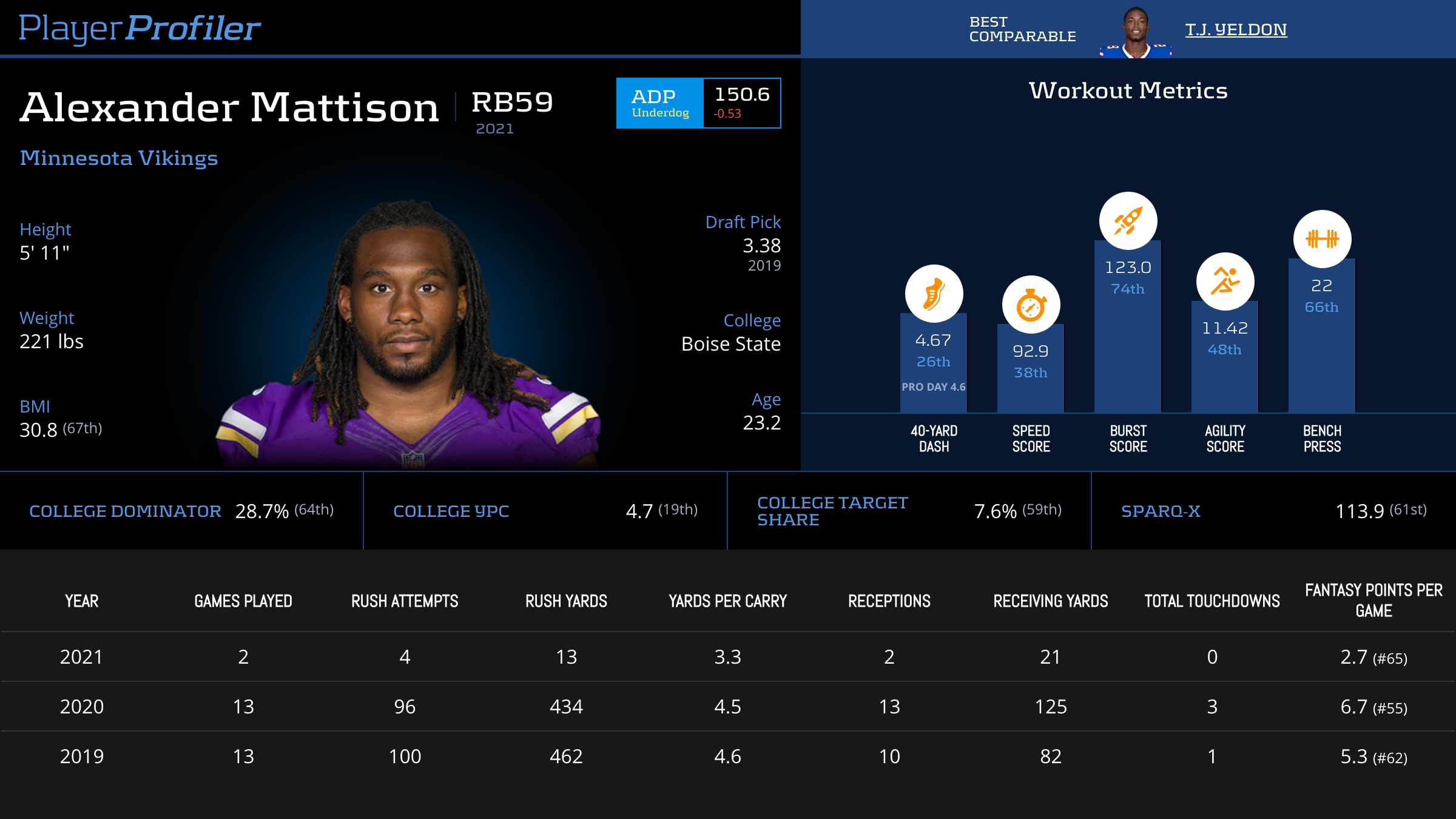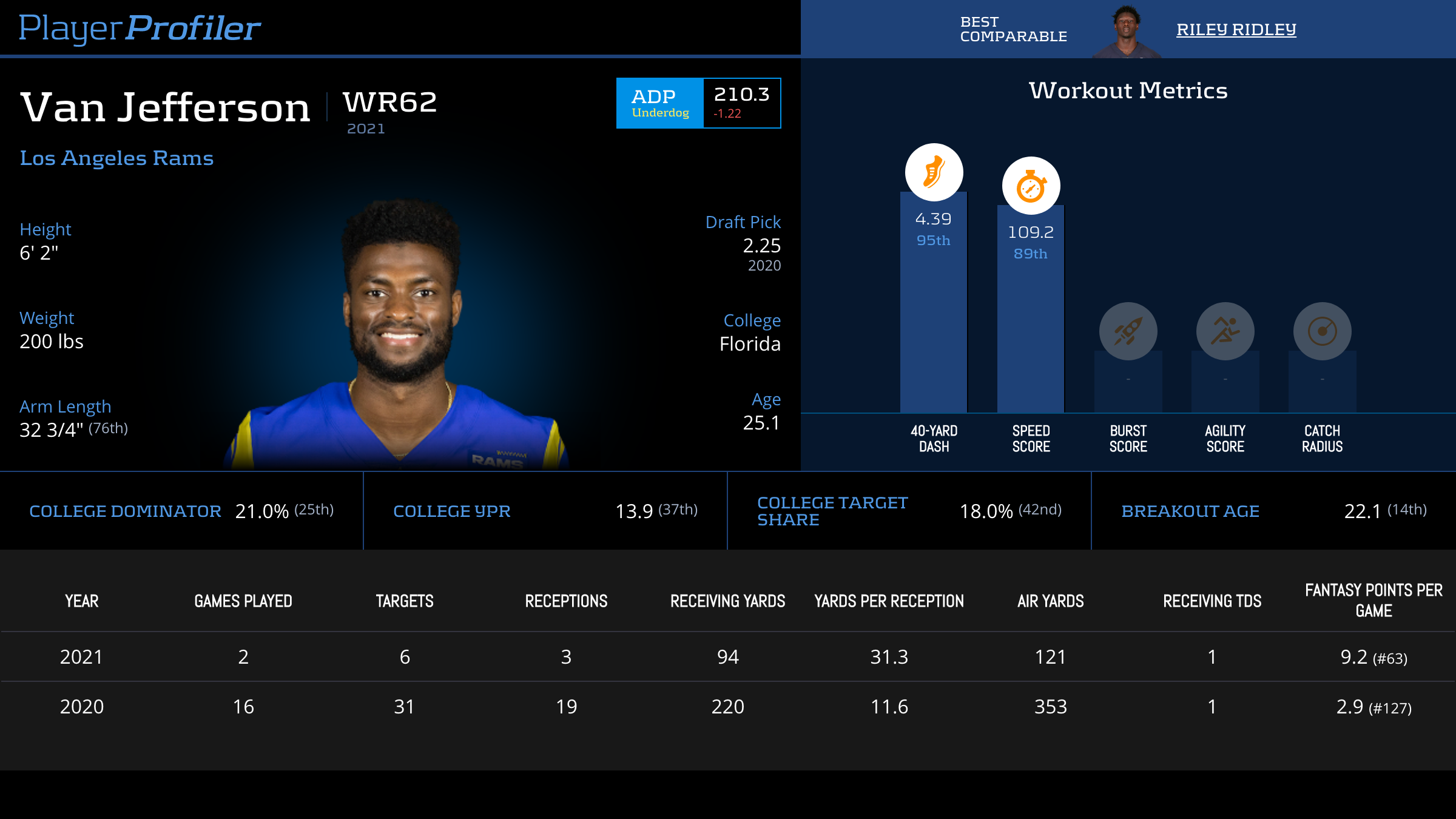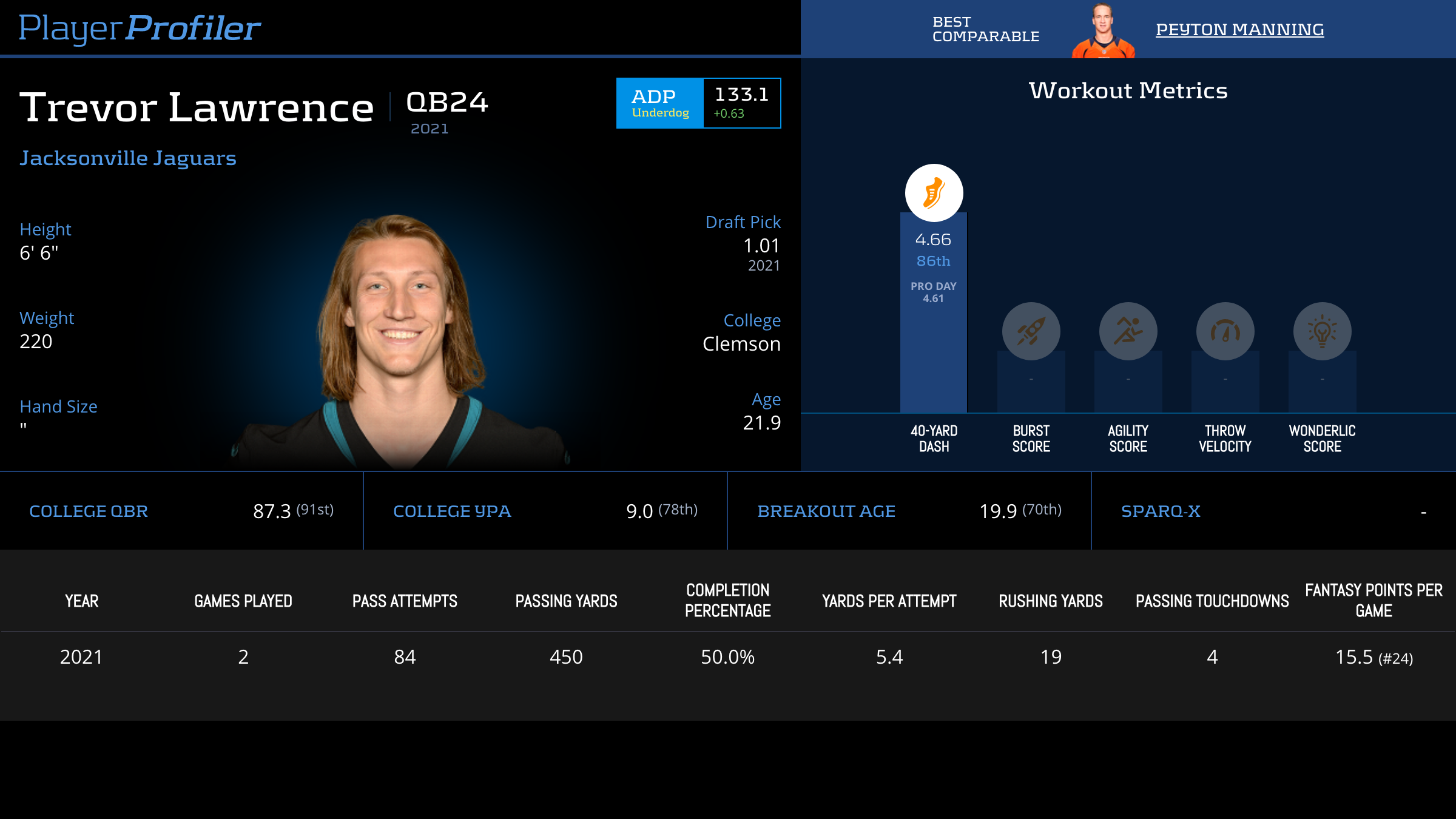Have you ever been on a date you felt intellectually went well but you know the other party will never call you?
Suffice to say Week 2’s DFS slate left me on read.
Between a cash lineup pulverized by Cooper Kupp, and a tournament build eviscerated by King Derrick Henry, it was a full-on brick in Week 2.
Here in the safe embrace of The Pareto Principals however, we move forward. We will reflect on what went wrong last week; and what quotient of the results were a reflection of poor process vs. unfortunate luck.
After this, we will look ahead to Week 3, with an emphasis on my favourite macro-strategies and a case study in how to handle an injured stud in the late game window.
NOTE: If this is your first time reading this column I encourage you to check out my introductory piece linked below. It covers the core principles of how I play tournament DFS, and a lot of the language you’ll see used in future editions of the column.
The Pareto Principals: Guiding Principles For Limited Entry DFS
Week 2 Results
In weeks like this, transparency is painful. It was a Week 2 wipeout, essentially placing me back to even on the year.
Week 2 Strategic Reflections
I won’t bother with lineup reviews this week since nearly all my tournament lineups late swapped from my initial build.
My strategy for the slate was based on the expected disparity in game environment between early and late games, and the disparity in ownership between Chargers-Cowboys and the remaining games.
I wanted to have my cake and eat it too. I ensured my lineups had at least a taste of the early games, either with a secondary correlation or a full-on stack; Bills or Eagles. Then, based on my standing after early games I would either play Chargers-Cowboys chalk if I was scoring well, or swap to lesser played options if I was falling behind. I wanted to create an information advantage on my opponents and leverage that in my favour.
My teams were dead on arrival to win first. I barely played Cooper Kupp; the highest scoring receiver on the slate. He was also among the most played, as I expected in my Week 2 preview. But I did make number of strong late swaps that nearly salvaged my day. Teams I swapped onto Buccaneers and Cardinals stacks made a valiant charge for the cash line. Only to be dashed by Derrick Henry.
Ironically, when I woke up Sunday morning, I had Henry in two of ten lineups. But in the furious late swapping, I needed to sacrifice him to make other pieces fit, and I was severely punished.
Week 2 Lessons
I think this week was a mix of bad luck and bad process. It was bad luck that Derrick Henry broke the slate to pieces, and there was viability to my late-swap oriented strategy. The bad process was being too tied to the notion that Chargers-Cowboys was the best game on the slate. I forced myself into sub-optimal early game plays to keep my options open to attack this game.
The better approach would have been playing the three other late games, betting on one to outpace the chalk. I could have created similar leverage, but never would have been forced off of plays I wanted to target, such as Henry. The theme of is column is profiting from uncertainty, but this week my play prioritized optionality over uncertainty. Reflecting back, I was too certain. I let an assumption about which game was ‘best’ orient my macro-strategy. It’s time to step back and work harder for a bounce back in Week 3.
Macro-Strategic Emphasis: Flipping the Build
It’s important to think of tournament lineups from a structural perspective. Most players start their lineup fixating on a given game or player, and build a lineup around it. But the amalgamation of players making similar decisions to start their lineup often leads to similar structures. This phenomenon is exacerbated by players using lineup optimizers without placing strict enough rules on the lineups it generates.
If you can reverse engineer this process, you can estimate the dominant field structure each week, and potentially identify undervalued plays.
Does this make sense? If not yet, let’s try another metaphor.
I’ll Have a Keenan Allen on Rye
Across the street from your office there is a deli and a coffee shop. Each day your boss gives you $10 to spend on lunch, and you can’t keep any change for yourself. Typically, you buy a sandwich at the deli for $7.50, leaving you $2.50 for coffee. But on Thursdays, the deli offers sandwiches for just five dollars. With your additional, remaining money, you order a mocha rather than coffee.
It’s not that you crave a mocha on Thursday more than any other day. You’re more likely to purchase a mocha based on changes in price to your primary lunchtime motivation; the sandwich.
Tournament lineups get built in a similar manner. In Week 1, the plethora of starting receivers under $4,000 (DraftKings) pushed additional ownership to elite running backs. In Week 2, the opposite occurred. The dominant build combined more expensive receivers in popular games, with mid-price running backs such as Najee Harris and Chris Carson.
This allowed stud running backs such as Derrick Henry and Dalvin Cook to be played at low roster percentages despite favourable game environments. Reversing the structural tendencies of the field will not always be as successful as last week. Nonetheless, it is a fantastic way to build a contrarian lineup without sacrificing high quality core plays.
Week 3 Dominant Structure
Analyzing early ownership projections, and taking broad view of the slate, makes me inclined to say the build mimics Week 2 more than Week 1.
Two games, Chargers-Chiefs and Buccaneers-Rams, jump off the page as excellent game environments. The running backs in this game are either undesirable or inexpensive, with Austin Ekeler being most expensive at $7,000. He stacks most naturally as a bring back with the Chiefs, but the cost may be prohibitive.
Early ownership projections suggest the most common builds will stack these games via their costly pass catchers. If Dalvin Cook misses this weekend, Alexander Mattison will add another avenue to remain cost-effective at running back.
The issue is without Cook on this slate, nearly all the high dollar running back ownership would consolidate around Derrick Henry and Alvin Kamara. Cook is currently questionable with a 4:25 PM ET kickoff, leaving us with a lot of uncertainty heading into the weekend.
The Dalvin Cook Problem
It is very plausible Dalvin Cook‘s status will be resolved prior to Sunday morning and this section of the column becomes moot. Nonetheless, there are sure to be future situations with similar injury uncertainty, and it’s valuable to discuss the strategic angles of how to approach it.
Last week’s late-swap oriented strategy went belly up. But I think there is a case to go back to the well if the Cook situation comes down to the wire. With only two strong game environments in the late window, many will steer clear of the Vikings backfield if we don’t have any clarity when people finalize their lineups. If this occurs, we can expect Cook or Alexander Mattison to be among the best projected plays on the slate and under-owned. Giving yourself the ability to take advantage either way is profiting from uncertainty.
Maintain Flexibility
In a truly 50/50 situation, I plan to build skeleton lineups pairing Alexander Mattison with premium pass catchers in the Rams-Buccaneers and Vikings-Seahawks games. This allows me to prepare for each potential scenario regarding the injury, and my lineup generally.
If Dalvin Cook plays, that’s the ideal scenario. There is no comparable swap option at running back, and Cook should come in under-owned relative to his projection. Pairing down from a Cooper Kupp, DK Metcalf or Mike Evans to a Freddie Swain, Scott Miller, or Van Jefferson can facilitate a swap, without altering the correlation in your build.
If it’s Mattison, this is a trickier scenario. At $6,000, he is not a markedly better play than Saquon Barkley ($6,500), Antonio Gibson ($5,900), or Chris Carson ($6,400) in a vacuum. Personally, I would gauge ownership in your contest by checking the play rates on early running backs in your contest; especially those in Mattison’s price range.
If we have reason to believe Mattison will be lightly rostered, I would be very interested. If he’s projecting to be chalk, I’d much rather pivot to Minnesota’s pass catchers.
Alternative Swap Options
Just because there are only two popular games in the late slate does not mean your options are limited. Especially for lineups struggling after the early session; Melvin Gordon, Myles Gaskin, Kenyan Drake, and Leonard Fournette should all be viable, at lower salary than Alexander Mattison and potentially less ownership.
The biggest difference in this approach vs. my error last week, is that optionality and uncertainty are aligned. Rather than spearheading my approach under the assumption of Chargers-Cowboys being the best game environment, I’m taking a stand that Mattison and Dalvin Cook, if projected to be under-played, have as strong a chance to pay off their price as any other player in a strong game environment, but can pay off further for my lineup. If my assumption on their ownership is looking to be incorrect, there are numerous other running back pivots, and this late swap plan requires only two slots preserved to the afternoon games, along with a defense.
Additional Leverage Opportunities
I would be remiss to spend the entirety of this article discussing hypotheticals of a Dalvin Cook injury that may or may not effect the slate.
Before I sign off today, I wanted to give two additional ideas I plan to play this week in at least one lineup.
The Under-Cats
Among the four games with a total above 50 on the main slate, two have spreads beyond a touchdown (Lions-Ravens and Cardinals-Jaguars). I expected to be overweight on Kyler Murray and Lamar Jackson this week, if the market decided to fade these projected blowouts in favour of Chiefs-Chargers and Rams-Buccaneers.
Especially early in the season, the market is too sure of who is capable or incapable of keeping pace with a good offence. This heuristic led me to being heavy on Tampa Bay last week vs. Atlanta.
Interestingly, ownership is projected to be flat between Murray and Jackson with the other top quarterbacks, yet the top plays on Jacksonville and Detroit project to be sparsely rostered. If you’re betting on Murray or Jackson, you are inherently betting on these games remaining competitive. I expect to be overweight on Marvin Jones, D’Andre Swift and D.J. Chark this week.
In the Jaguars-Cardinals game specifically, I will play the Jaguars side altogether. No team passes at a higher rate in neutral situations, or in total, than Jacksonville this year. Two weeks is far too early for me to write this team off completely. Playing Trevor Lawrence with two Jaguars pass catchers gives you massive flexibility on salary and ownership to attack the rest of the slate however you please.
Flipping the Narrative
It is fascinating to see which usage trends the market buys into and which they are selling after two weeks. Robert Woods has fallen behind Cooper Kupp in the Rams pecking order thus far, but his Week 2 usage was actually strong in a vacuum. He ran 97-percent of routes, had a 29-percent Target Share, and 38-percent Air Yards Share. He is now $1100 cheaper than Kupp, and projected for nearly half the ownership.
Meanwhile, for Los Angeles’ other franchise, Mike Williams has looked every bit a co-alpha alongside Keenan Allen. Draftkings has responded, with only a $200 gap in salary. Nonetheless, ownership is projected to remain much heavier on Allen.
I have no firm take on whether these role changes are certain to stick. None of us can be sure, and even if we’re wrong in the long run, variance could hit for either player in Week 3. I would rather bet against the market’s take more often than not in a game of probability.
The Final Word
It’s redemption time. We’ve gone back to the drawing board, examined the fundamentals, and prepared for a Week 3 comeback. I’m excited to be back with you next week to discuss how it turned out, and keep talking DFS strategy for Week 4.





